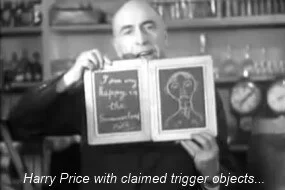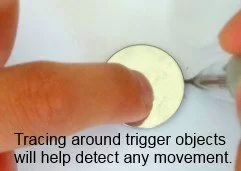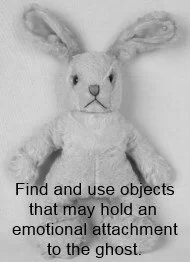Learn about 'trigger objects' and their significance with ghosts and haunting...
Cases of haunting have long been known to involve the movement of objects. This has led to much speculation as to how an item might have been moved:
- Was the object touched by a ghost?
- Did the object truly move on its own or, possibly, by someone accidently or fraudulently?
- Could the movement have been by some natural cause or even through the witness' own psychokinesis?
These are but some of the many questions that have been explored by researchers.
 Ghost Investigation: What Is a Trigger Object?
Ghost Investigation: What Is a Trigger Object?
When a haunting is active, witnesses may report observing something moving - it could be one or multiple items. But if there is one item that seems central to the odd activity, then that is a 'trigger object' of that particular case.
It is also a common practice to use items during ghost investigation to see if a 'trigger object' can be found - something that will cause an active ghost to respond to paranormal investigators, proving the presence of an intelligent, invisible entity.
Investigating the Moving Object: Is It a Ghost?
If you have an object of focus, something that seems central to the haunting, then you want to first investigate the movement. Some areas to explore:
- Can there be any natural explanation for its movement? (First assume it is NOT a ghost.)
- Can you run an experiment to make the object move on its own (e.g. Would a person walking by make it move?)
- Can you capture the movement of the item on video for closer study?
- Did something happen before the object moved; is its movement tied to something else happening in the area? (e.g. Did an appliance turn on, then the item moved?)
After you examine the phenomen more closely, and if you cannot find a natural explanation for it, then you are dealing with something 'paranormal.' That just means it is 'beyond normal explanation.' It is now time to determine if the moving object is supernatural.
How to Use Trigger Objects with Ghost Investigation
Let's understand a bit better the haunt you are investigating by attempting to piece some of the story together. If you can develop a theory based upon the story and any evidence, it is possible to test the idea.
- What have people seen or experienced to make them believe a ghost is at work?
- Who do witnesses believe the entity to be? Is the ghost sentient (aware - an intelligent haunting) or non-sentient (e.g. residual haunting)
- What connection might the ghost have with the trigger object and why are they making themselves known?
Begin to experiment with the trigger object to reach the person who is unseen.
Encourage ghosts to move trigger objects by talking about them openly- be sure and audio record such sessions. Your goal: Attempt to confirm who is haunting and how you can help. If you can figure this out, and if you can help the disembodied soul reconnect with loved ones in spirit (by heading into the light), then the haunting should end and the ghost should be freed. Ghost investigation should be fun and rewarding but with an objective in mind beyond the experience.
How to Use Trigger Objects
 When using a objects to test movement, it is desirable to keep the experiment clean. That means eliminating access to the room where the trigger object is placed while ensuring nothing in the room, such as any appliance that may cause vibration or sound, can result in the object's movement. If an investigator is in the room with the trigger object, he or she should not be close to the trigger item or sitting on the same surface as it (e.g. the object and the investigator both sitting on a couch).
When using a objects to test movement, it is desirable to keep the experiment clean. That means eliminating access to the room where the trigger object is placed while ensuring nothing in the room, such as any appliance that may cause vibration or sound, can result in the object's movement. If an investigator is in the room with the trigger object, he or she should not be close to the trigger item or sitting on the same surface as it (e.g. the object and the investigator both sitting on a couch).
Video record the experiment so any movement will be easier to detect and validated. If the trigger object is small, such as a coin, place it on a piece of paper and trace around it with a pencil. The boundary of the pencil line will mark its exact spot. Write instructions to the ghost on the paper where your item is placed, especially if left alone in the room. Another method is to use masking tape if paper cannot be used. Again, leave a note for the ghost.
 There are two types of trigger objects that may be used with the experiment:
There are two types of trigger objects that may be used with the experiment:
- an item that is already experiencing paranormal movement
- an item associated with the deceased person (the ghost)
The object of choice should be chosen to have the best chance at making an emotional connection with the lost spirit.
There are two ways to use the trigger object:
- Leave the room altogether, block access to it and allow a video recorder to capture any movement.
- Remain in the room, asking the ghost to move the object. If the object moves, attempt 'yes and no' questioning with the ghost. ("If the answer is 'yes,' then please move the object.")
Trigger Object Ideas You Can Try
Try and match your trigger object with the facts of the case. (Be sure and not select something for your experiment that can move on its own such as a ball.) If a child ghost is believed to be there, then choose a toy. If an old man, then use one of his possessions. If you do not know how to tie the trigger object to the ghost, then why not try using something colorful and out of place to spark some reaction? The point is to use some logic behind your choice in order to gain the best chance at triggering your ghost into action. You are trying to connect with the ghost's emotions.
Some suggested trigger objects: jewelry, coins, non-electrical toys (e.g. stuffed animal), a watch, clothing, a book, a pipe, religious or wartime objects, photos
Interesting Note:
Famous ghost investigator, Harry Price, used trigger objects while investigating the famously haunted Borley Rectory. Items were placed in different rooms in the attempt to attract the ghosts into interacting with him and his co-investigator (Howe). Notably, a cigarette carton and match box was used to try and tempt a former smoker to respond. (See Ghost Hunting Equipment of Harry Price)
Related Reading...
Singapore Theory

